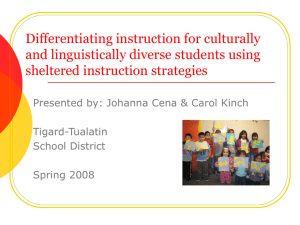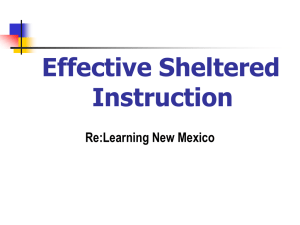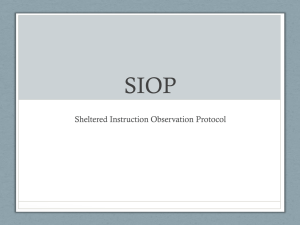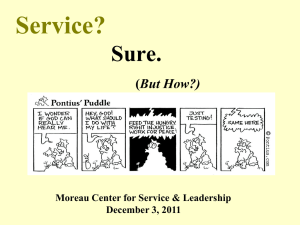Who are our students? - Center for the Education and Study of
advertisement
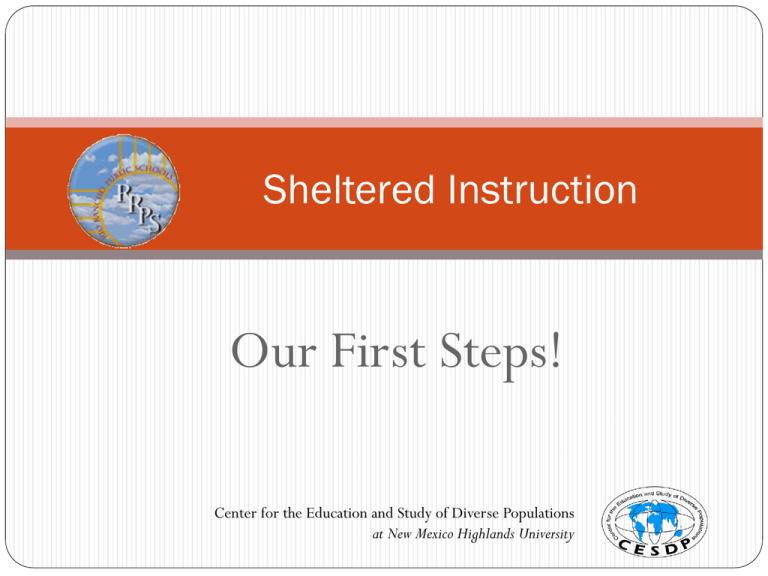
Sheltered Instruction Our First Steps! Center for the Education and Study of Diverse Populations at New Mexico Highlands University The Sheltered Instruction Observation Protocol 2 Who are our students? English Language Learners Children of Poverty ALL Children 3 Sheltered Instruction Objectives: • Participants will develop a working knowledge of the first 3 components of sheltered instruction. • Participants will brainstorm ideas on how to develop a systemic plan for the implementation of sheltered instruction. 4 Sheltered Instruction How we will meet our objectives: Participants will recall and list topical information from readings, previous trainings and personal experiences. Participants will articulate and listen to various points of view related to the day’s topic. Participants will negotiate meaning from and respond to essential questions related to sheltered instruction and the SIOP Model. 5 Sheltered Instruction How we will meet our objectives: Participants will practice creating written language objectives as related to the needs of their lessons and the students they serve. Individually and in groups, participants will begin to synthesize the day’s information through dialogue and reflection. 6 Sheltered Instruction What is sheltered instruction? What are our assumptions about the Sheltered Instruction Observation Protocol (SIOP)? 7 Sheltered Instruction On the surface sheltered instruction represents: An instructional model for lesson planning and delivery; and The observation instrument for rating the fidelity of lessons to the model. 8 Sheltered Instruction Two essential tenets of the instructional model include: Content Objectives; and Language Objectives. •What do these concepts mean to you? •Which one is done consistently? •How is this related to our first dialogue? 9 Eight Core Components of High Quality Sheltered Instruction Preparation Interaction Building Background Practice / Application Comprehensible Input Strategies Lesson Delivery Review / Assessment Sheltered Instruction Building Background Schema Theory What do these concepts mean to you? How do they apply to our first conversation? Do we know if this is done? 11 Sheltered Instruction Comprehensible Input Speech Wait time Clarity What do these concepts mean to you? How do they apply to our first conversation? Do we know if this is done? 12 Thinking Systemically What do we need to ensure this will become systemic and effective? 13 A TypicalLesson Plan begins with a … Focus: Content Objectives Language Objectives Aligned to Standards 14 A Typical Lesson Plan Includes … Instruction: Through the lens of the language demands of the content. Student Centered • Previous Learning (PK) • Building of Background Knowledge • Interdisciplinary Connections 15 Frontloading, Scaffolding, Sheltering • Bricks • Mortar Key Vocabulary A Typical Lesson Plan Includes … Guided Practice: Reading Writing Listening Speaking Sheltered & Rigorous 16 Formative Assessment Opportunities (Informal and Formal) Opportunity for Interaction: Enhancing Academic Language Discourse A Typical Lesson Plan Includes … Independent Practice: Reading Listening Writing Speaking Sheltered & Rigorous 17 Formative Assessment Opportunities (Informal and Formal) Let’s Practice! Verbs for Language Objectives Listen Identify Classify Collect Distinguish Categorize Match Show Select Construct Assemble Arrange Name Recall Give Examples Draw Organize Decide Create Dramatize Locate List Underline Review Compose Dictate Point out Record Report Predict Express Plan Evaluate Relate Respond Describe Interpret Outline Summarize Suppose Estimate Judge Explain Debate Illustrate Infer Revise Rewrite Assess Justify Generalize Demonstrate Restate Tell Observe Sequence Synthesize Recite Elaborate Define Apply Pre-write Draft Publish Write Negotiate Critique Compare Contrast Question Map Discriminate Lesson Preparation Sample Content and Language Objectives 9th Grade Geometry Content Objective: 9-12.G.1.2 Find the area and perimeter of a geometric figure composed of a combination of two or more rectangles, triangles, and/or semicircles with just edges in common. Language Objectives: With your learning partner you will use mathematical vocabulary to explain the process for finding the area and perimeter of geometric figures. During a carousel activity, your group will construct aVenn Diagram to contrast and compare the area and perimeter of one geometric figure to another. Work in pairs to solve and justify statements about the area and perimeter of geometric figures. 21 Let’s Practice Again! Building Background T-Chart and Conversation 10 mins What did I see? What did I think about what I saw? How consistently and explicitly do we do this? Let’s Practice One More Time! Did we accomplish our objectives? Participants will develop a working knowledge of the first 2 components of sheltered instruction. Participants will brainstorm ideas on how to develop a systemic plan for the implementation of sheltered instruction. Thank you! Adrian Sandoval aisandoval@cesdp.nmhu.edu Phone: 505-243-4442 Center for the Education and Study of Diverse Populations at New Mexico Highlands University 31
